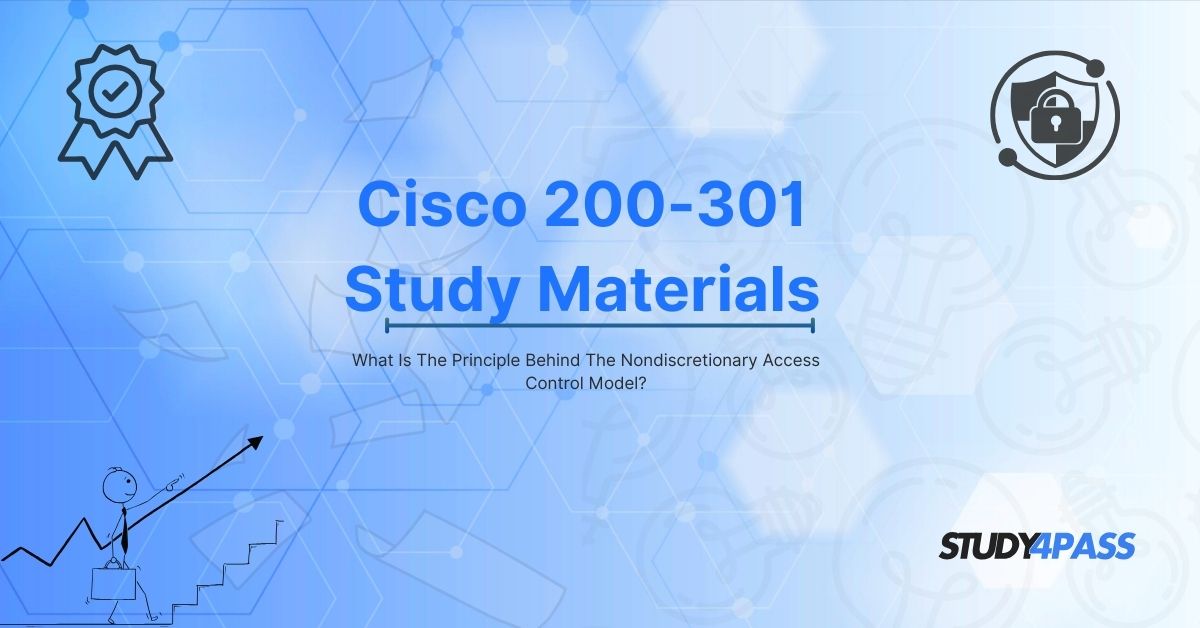Introduction to Access Control Model
Access control is a fundamental concept in cybersecurity, ensuring that only authorized users and systems can access specific resources. One of the key models used in access control is the Nondiscretionary Access Control (NDAC) model, which plays a crucial role in maintaining security in enterprise environments.
For students preparing for the CCNA SECFND (200-301) exam, understanding NDAC is essential, as it forms part of the foundational security principles tested in the certification. This article provides an in-depth explanation of the Nondiscretionary Access Control model, its principles, types, advantages, and role in network security. Additionally, we will highlight how Study4Pass offers high-quality study materials to help you master these concepts effectively.
What Is Access Control?
Before diving into NDAC, it’s important to understand access control in general. Access control mechanisms regulate who or what can view or use resources in a computing environment. The three primary access control models are:
- Discretionary Access Control (DAC) – Owners decide access permissions.
- Mandatory Access Control (MAC) – System-enforced access based on security labels.
- Nondiscretionary Access Control (NDAC) – Centralized authority controls access based on roles or rules.
Among these, NDAC is widely used in organizations where strict control over resource access is necessary.
What Is the Nondiscretionary Access Control (NDAC) Model?
The Nondiscretionary Access Control (NDAC) model is a security framework where access decisions are not left to individual discretion but are instead managed by a centralized authority. Unlike DAC, where resource owners set permissions, NDAC relies on predefined rules, roles, or attributes to enforce access policies.
Key Principles of NDAC
- Centralized Management
- Access permissions are determined by administrators or security policies, not by end-users.
- Ensures consistency and reduces security risks from misconfigured permissions.
- Role-Based Access Control (RBAC) – Permissions are assigned based on job functions.
- Rule-Based Access Control (RBAC) – Access is granted based on system-enforced rules.
- Permissions can change dynamically based on user roles, time, or location.
- Users are granted only the minimum access necessary to perform their tasks.
Types of Nondiscretionary Access Control
NDAC can be implemented in different ways, with the two most common approaches being:
1. Role-Based Access Control (RBAC)
- Access rights are assigned based on user roles (e.g., Admin, Manager, Employee).
- Simplifies permission management in large organizations.
- Example: A network admin has full access to routers, while a helpdesk technician has limited access.
2. Rule-Based Access Control (RuBAC)
- Access is determined by system-enforced rules (e.g., firewall rules, time-based restrictions).
- Example: Employees can access the database only during work hours.
Advantages of Nondiscretionary Access Control
- Enhanced Security
- Reduces risks of unauthorized access since permissions are strictly controlled.
- Ideal for large organizations where manually assigning permissions is impractical.
- Helps meet regulatory requirements (e.g., HIPAA, GDPR) by enforcing strict access policies.
- Limits excessive privileges, preventing misuse by employees.
NDAC in the CCNA SECFND (200-301) Exam
The CCNA SECFND (200-301) exam tests candidates on fundamental security concepts, including access control models. Understanding NDAC is crucial because:
- It is commonly used in enterprise networks.
- It aligns with Cisco’s security best practices for network device access.
- Questions may involve differentiating between DAC, MAC, and NDAC.
How Study4Pass Helps You Master NDAC for CCNA SECFND?
To excel in the CCNA SECFND exam, you need reliable study materials that explain complex topics in an easy-to-understand manner. Study4Pass provides:
Comprehensive Study Guides – Detailed explanations of NDAC, RBAC, and other security models.
Practice Questions – Test your knowledge with exam-like questions.
Hands-On Labs – Simulate real-world scenarios to reinforce learning.
Up-to-Date Content – Aligned with the latest CCNA 200-301 exam objectives.
By choosing Study4Pass, you get structured learning resources that help you grasp Nondiscretionary Access Control and other critical security topics efficiently.
Final Words
The Nondiscretionary Access Control (NDAC) model is a cornerstone of modern cybersecurity, ensuring that access to resources is managed centrally and securely. For CCNA SECFND (200-301) exam candidates, mastering NDAC is essential for understanding how enterprises enforce security policies.
With Study4Pass, you gain access to top-tier study materials that simplify these concepts, helping you pass the exam with confidence. Whether you're learning about RBAC, RuBAC, or MAC, Study4Pass provides the resources you need to succeed.
Start your journey toward Cisco Certification today with Study4Pass – your trusted partner in IT certification preparation!
Special Discount: Offer Valid For Limited Time “Cisco 200-301Exam Guide”
Sample Questions for Cisco 200-301 Exam
Actual exam question from Cisco's 200-301 Study Materials .
1. Which of the following best describes Nondiscretionary Access Control?
a) Users have full control over resource permissions.
b) Access decisions are made by system administrators or automated policies.
c) Access is determined by the data owner’s preferences.
d) Permissions are assigned based on user seniority.
2. In Nondiscretionary Access Control, who typically defines the access rules?
a) Individual users
b) System administrators or security policies
c) The operating system automatically
d) External hackers
3. Which access control model contrasts with Nondiscretionary Access Control by allowing resource owners to set permissions?
a) Mandatory Access Control (MAC)
b) Discretionary Access Control (DAC)
c) Role-Based Access Control (RBAC)
d) Rule-Based Access Control (RBAC)
4. Nondiscretionary Access Control is often used in environments that require:
a) Flexible, user-defined permissions.
b) Strict, centrally managed security policies.
c) No authentication mechanisms.
d) Publicly accessible resources.
5. Which of the following is an example of Nondiscretionary Access Control?
a) A file owner setting read/write permissions for others.
b) An IT department enforcing access rules based on job roles.
c) Users sharing passwords freely.
d) A system allowing anyone to modify security settings.


